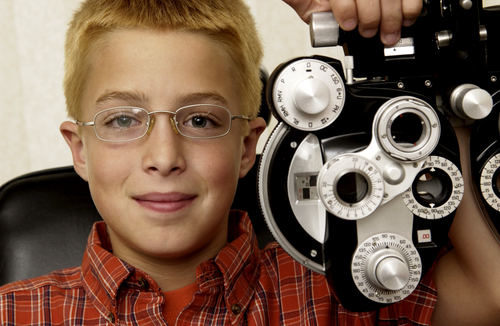Studies have shown that poor eyesight correlates with poor performance in school. Early detection and prompt treatment of ocular disorders in children is important to avoid lifelong visual impairment.
Dr. Robert Hoffman, pediatric ophthalmologist with the Moran Eye Center at University of Utah Health Care brings you up-to-date on what you need to know about your child’s eye health.
When should children have their vision checked?
Vision assessment beginning at birth has been endorsed by the American Academy of Pediatrics, the American Association of Pediatric Ophthalmology and Strabismus, and the American Academy of Ophthalmology.
• Newborn infants should have their eyes checked while still in the hospital nursery. This examination in the nursery should be for general eye health and include a red reflex test, which can help detect several congenital eye problems.
• From birth to 2 years of age, during regular well baby exams, pediatricians should use history and a vision evaluation to see if vision problems exist.
• Beginning at three years of age vision screenings should be performed to test for the following:– Strabismus (crossed eyes)
– Amblyopia (lazy eye)
– Ptosis (drooping of the upper eyelid)
– Color Deficiency (color blindness)
– Refractive Errors (nearsightedness, farsightedness, astigmatism)
If a child fails a vision screening or there is any concern of an eye or vision problem the child should be referred to a pediatric ophthalmologist or an eye care specialist appropriately trained to treat pediatric patients.
Keeping children safe from eye injuries
• Understand the dangers
• Find and remove hazards
• Watch your child closely
Playing with toys or sports
• Read all warnings and instructions on the box.
• Ask yourself if the toy is right for your child’s ability and age.
• Avoid purchasing toys with sharp or rigid points, spikes, rods, or dangerous edges.
• Check the lenses and frames of children’s sunglasses; many can break and cause injuries.
• Buy toys that will withstand impact and not break into dangerous shards.
• Look for the letters “ASTM.” This means the product meets the national safety standards set by the American Society for Testing and Materials (ASTM).
• Avoid toys that shoot or include parts that fly off.
Remember that BB guns are NOT toys.
— Source: Prevent Blindness Association
Common causes of eye injuries to children
• Sports: make sure children wear protective eyewear
• Misuse of toys: avoid toys with sharp, protruding part. Toys should be age appropriate.
• Falls from and against furniture or on stairs
• Misuse of every day tool and objects
If you notice any of these signs, get medical help right away.
• Your child has obvious pain or trouble seeing.
• Your child has a cut or torn eyelid.
• One eye does not move as well as the other.
• One eye sticks out compared to the other.
• The eye has an unusual pupil size or shape.
• There is blood in the clear part of the eye.
• Your child has something in the eye or under the eyelid that can’t be easily removed.
Call 801-581-2352 for more information or to schedule an appointment with the Moran Eye Center or check out the University of Utah Health Care website at www.healthcare.utah.edu















Add comment